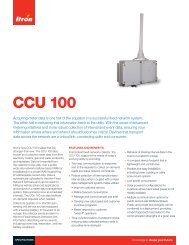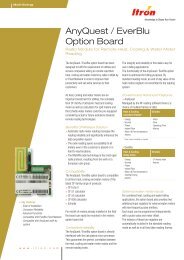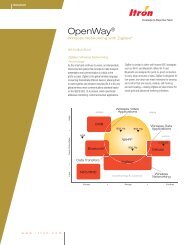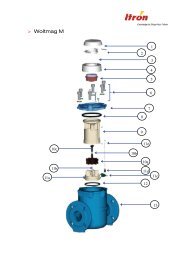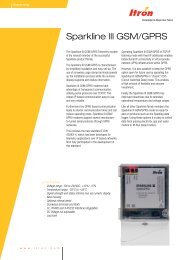Avista's Smart Grid Journey: - Itron
Avista's Smart Grid Journey: - Itron
Avista's Smart Grid Journey: - Itron
- No tags were found...
You also want an ePaper? Increase the reach of your titles
YUMPU automatically turns print PDFs into web optimized ePapers that Google loves.
®Avista’s<strong>Smart</strong> <strong>Grid</strong> <strong>Journey</strong>:Technology, Innovation, andSuccess Along the WayBy Mike Smith, Vice President,Utility Analytics Institute,a division of Energy Central
Avista’s <strong>Smart</strong> <strong>Grid</strong> <strong>Journey</strong>Avista’s <strong>Smart</strong> <strong>Grid</strong> <strong>Journey</strong>:Technology, Innovation, and Success Along the WayThe smart grid and smart metering market in North America has received its share of publicity:billions of dollars in investment, customer benefits, and yes, some customer challenges,too. But the real story, one that is often lost to the more glitzy stories of money and passionsurrounding these projects, is one of how utilities are leveraging these intelligent infrastructureinvestments to improve their operations across the enterprise, particularly in a utility’s grid andcustomer operations.Nowhere is this more apparent than at Avista Utilities. We recently had an opportunity to talkwith some of the people at Avista that are charged with making these investments pay off. Thestory at Avista is one of people applying their hard work and passion to create value for the utility’sstakeholders: customers, employees, shareholders and the community as a whole. At Avista, thesebenefits include a more reliable and efficient grid, along with an improved customer experience.Avista Utilities provides service to more than 600,000 electric and natural gas customers. Avistais based in Spokane, Washington, the heart of the inland Northwest. Their service territory covers30,000 square miles and includes a population of 1.5 million in eastern Washington, northernIdaho and parts of southern and eastern Oregon. The company, formerly known as the WashingtonWater Power Company, has a rich history of embracing renewable energy, innovation, and servinga diverse customer base across mountains, high desert, cities, and agricultural areas.Figure 1.Avista UtilitiesHeadquartersin Spokane,Washington2 /// <strong>Itron</strong> Thought Leadership /// April 2013
Avista’s <strong>Smart</strong> <strong>Grid</strong> <strong>Journey</strong>It Really is a <strong>Journey</strong>It has been said that utilities that venture down the smart grid and smart metering path mustunderstand that it truly is a journey and not a destination. Consider where the North Americanutility industry is today vis-à-vis the smart grid, which we’ll define as including smart meters. Inmany cases, the smart grid is built. Done.But this is really just one stop along the journey. As you can see in the figure below, a criticalmass of North American utilities are arguably entering into what we call the “Value Phase” of thesmart grid era.2000-2010 2007-2012 2010-2020DevelopmentPhaseInfrastructurePhaseValuePhaseConceptScopingInvestmentDesignBuild out <strong>Smart</strong> <strong>Grid</strong>Install <strong>Smart</strong> MetersTechnologyImplementationIdentifying ROIRenewables IntegrationEV GrowthIntell. Asset Mgmt.<strong>Grid</strong> OptimizationMuch/most of the value willbe driven by AnalyticsTechnology Aligns withBusiness & Regulatory RequirementsFigure 2. The <strong>Smart</strong> <strong>Grid</strong> EvolutionSource: Utility Analytics InstituteAs one can see from Figure 2, “Value Phase” is dominated by data-rich applications that leveragea utility’s investment in the smart grid…this is what is generating all of the data. This point in thejourney is where we pick up the Avista story.Avista has several different initiatives that land clearly in the “Value Phase” of the smart gridjourney. The balance of this paper will provide a glimpse into, and some perspectives from, theseinitiatives and the value they are creating.3 /// <strong>Itron</strong> Thought Leadership /// April 2013
Avista’s <strong>Smart</strong> <strong>Grid</strong> <strong>Journey</strong>The First Stop on the <strong>Journey</strong>: Cost-Effective ReliabilityWhen the smart grid was first making waves in the late 2000s, most of the focus was on thesmart meter itself. With many smart meter installations completed across the country, attentionhas now shifted to the value of the data across the network. At Avista, the utility’s leadershiprecognized that having this intelligence at the endpoints (<strong>Itron</strong> OpenWay® smart meters at thecustomer premise) coupled with the two-way communications infrastructure would provide someopportunities to manage the reliability of the grid that were previously not possible.Starting with a pilot project in the city of Pullman, WA, Avista has installed 13,000 smart meters forelectric utility service, plus another 5,000 for gas service. The Pullman pilot is in conjunction withAvista’s participation in the Pacific Northwest <strong>Smart</strong> <strong>Grid</strong> Demonstration Project led by BattelleNorthwest — the largest smart grid demonstration project in the nation.Curt Kirkeby, <strong>Smart</strong> <strong>Grid</strong> Principal Investigator at Avista, commented on the effectiveness ofthe project in Pullman: “The smart meters and their two-way connectivity across the grid areproviding us with visibility into the voltage levels at every endpoint. Working back from there wesee that their biggest value is in providing us with the data necessary to lower voltages across thegrid while maintaining service levels to our customers.”Kirkeby went on to explain that having this voltage data in near real-time has enabled Avista’sdistribution staff to maintain and improve reliability to their customers while lowering costs bybeing able to regulate voltages across the grid within tighter thresholds. This means that less powerhas to be sent down the line to ensure reliability, which ultimately lowers operating costs.One of the benefits to performing this project in such a targeted area of Avista’s service territorymeans that they can look at the results in Pullman and compare these against the rest of theirsystem to identify how much more cost savings they are able to achieve from having the richerdata. In other words, they will be able to gauge the optimal level of automation and intelligence toprovide an optimized grid as they plan for future investments to modernize their entire system.This level of intelligence also enables more visibility into the distribution network via configurationmanagement, performance monitoring and network fault monitoring. One big plus: the grid canbe automatically reconfigured for reliability. This is achieved via a “lockout,” which determineswhich section needs to be isolated and then restores power to both the upstream and downstreamcustomers. This pushes the decision to an automated solution, or even to the dispatcher insome cases. Ultimately, customers are the big winners, because they experience fewer andshorter outages.4 /// <strong>Itron</strong> Thought Leadership /// April 2013
Avista’s <strong>Smart</strong> <strong>Grid</strong> <strong>Journey</strong>Curt Kirkeby again explained the implications from this capability: “The key differentiator here ishaving faster responses, either in a fully automated scenario or in one where a dispatcher can makea quick decision. With these near real-time capabilities we no longer need to rely on distributionengineering or management staff to make decisions to keep the lights on. Essentially, we’ve pusheddecision making away from the depths of our organization and kept it where it needs to be: closerto the customer.”Next Up: EfficiencyThe Pullman project brings an added benefit: remote connect/disconnect and remote reading foraccount closing/opening. From a process standpoint, this saves truck rolls and uses fewer Avistastaff to close the transaction with customers.Dan Burgess, a Senior Analyst at Avista, commented on the business impact of these remotecapabilities: “The trick for us is to be able to manage costs while also providing an improvedcustomer service environment; it’s a classic case of needing to do more with less. We need tomanage and measure how these abilities are helpful to the customer and how they are impactingour operational numbers. To this end we are measuring how fast we turn on/off a customer. We arehappy to report improvements across our response time metrics, and we expect to see increases inthe customer satisfaction scores we are tracking.”Dan noted the dual business benefit this function provides, through automated power turnons,the utility can minimize lost revenue while improving customer satisfaction because theautomation allows us to be more responsive to customers’ turn-on requests.The Road AheadThese early successes have created an impetus for Avista leadership to apply analytics acrossmany different customer and grid operational areas. The Avista analytics leaders are now applyinga more predictive analytics approach to many areas of their business. This includes some of thegame-changing analytics applications in revenue protection and theft detection, an age-oldproblem with some entirely new solutions and resulting improvements.In recent years, Avista’s call center operations have already seen the benefits from leveragingspeech analytics to improve customer communications and engagement. For example, byunderstanding why customers call multiple times, or by identifying emerging issues early,Avista can identify opportunities to proactively address customer issues and improve thecustomer experience.5 /// <strong>Itron</strong> Thought Leadership /// April 2013





